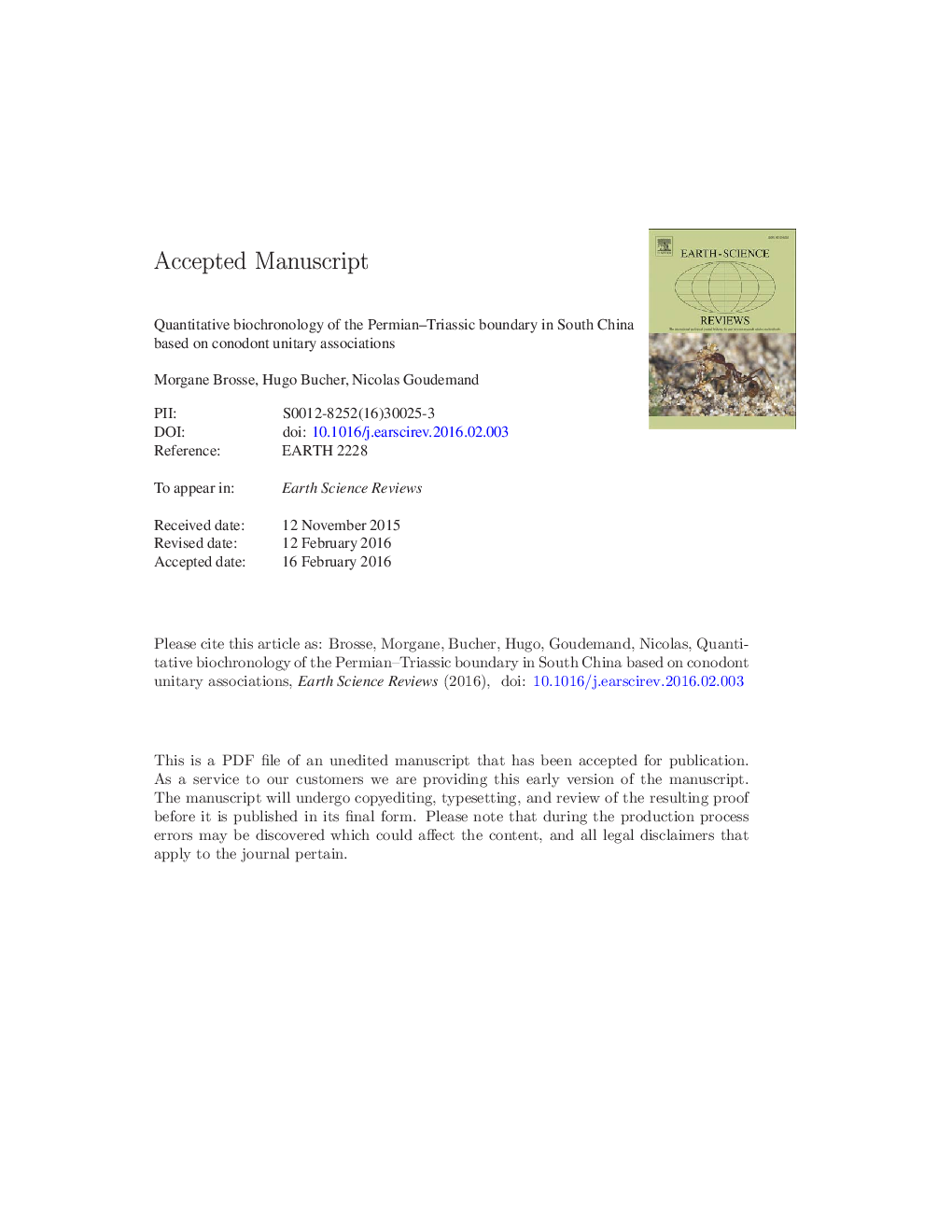| کد مقاله | کد نشریه | سال انتشار | مقاله انگلیسی | نسخه تمام متن |
|---|---|---|---|---|
| 6442886 | 1639947 | 2016 | 56 صفحه PDF | دانلود رایگان |
عنوان انگلیسی مقاله ISI
Quantitative biochronology of the Permian-Triassic boundary in South China based on conodont unitary associations
ترجمه فارسی عنوان
زیست شناختی کمی از مرز پرمین-تریاس در جنوب چین بر اساس انجمن های یکپارچه کانودونت
دانلود مقاله + سفارش ترجمه
دانلود مقاله ISI انگلیسی
رایگان برای ایرانیان
کلمات کلیدی
مرز پرمین-تریاس، انجمن های یونیتی، انقراض جمعی، کنودوکس، جنوب چین،
موضوعات مرتبط
مهندسی و علوم پایه
علوم زمین و سیارات
زمین شناسی
چکیده انگلیسی
The biochronological characterization of the Permian-Triassic boundary (PTB) is here improved by means of conodont unitary associations zones (UAZs). The selected data set comprises the six best documented sections in South China, including the Meishan global stratotype section and point of the PTB. This new biochronological zonation has a much higher accuracy than previous schemes, which were based on continuous interval zones. We show how traditional interval zones around the PTB in South China suffer from diachronous boundaries that cross each other as the result of sampling effort (intensity and density) and of geographical or ecological exclusion of zonal index taxa, inclusive of the first occurrence of the base Triassic index species Hindeodus parvus. Our quantitative and robust approach produces a discrete sequence comprising six UAZs. In the closest agreement with the position of the PTB in Meishan, the PTB falls here in the interval of separation between UAZ2 and UAZ3. In Meishan, this interval of separation corresponds to the stratigraphic interval above bed 25 and below bed 27, which also includes the formational boundary between the Changhsing and the Yinkeng formations. We provide a new and independent support for this placement by showing that it correlates with the main turnover of conodont species within the analysed time interval. As previously documented, the main extinction interval ranged from bed 25 to bed 28 in Meishan, which are here assigned to UAZ2 and to UAZ4, respectively. Therefore, the main extinction episode is not of end-Permian age but straddles the PTB. Previous claims for two distinct extinction pulses bracketing the PTB in South China were based on traditional conodont interval zones and are not supported by the new UA zonation. The oldest Triassic UAZ3 is identified by the characteristic species Hindeodus pisai and by any of the ten characteristic pairs of species Neogondolella zhejiangensis or Neogondolella tulongensis associated with Hindeodus changxingensis, Hindeodus parvus, Neogondolella planata, Neogondolella taylorae or Isarcicella huckriedei. Separate analyses of anchignathodontids and neogondolellids sub-data sets show that the base of the Triassic is unambiguously defined by the occurrences of the characteristic species H. changxingensis, Isarcicella prisca, and I. huckriedei in shallow-water settings, and of two characteristic species, N. planata and N. taylorae, in deep-water settings. Moreover, we document uncoupled diversity trends across the PTB for each of these two clades. A substantial diversification phase of anchignathodontids spans the interval from UAZ3 to UAZ5. It is followed by a drastic (50%) reduction of the number of species between UAZ5 and UAZ6. On the other hand, neogondolellids show a protracted extinction from UAZ4 to UAZ6. In South China, correlations are proposed for the microbialite-bearing sections and deeper-water PTB sections. The UA method also highlights which parts of the conodont record are still insufficiently documented for reliable correlations. Biochronological correlations with Meishan and its U-Pb radio-isotopic ages allow inferring a maximal duration of 61 ± 48 ka for the gap at the base of the Triassic microbial limestone at Dajiang, a time interval that also corresponds to the duration of the main extinction episode in Meishan.
ناشر
Database: Elsevier - ScienceDirect (ساینس دایرکت)
Journal: Earth-Science Reviews - Volume 155, April 2016, Pages 153-171
Journal: Earth-Science Reviews - Volume 155, April 2016, Pages 153-171
نویسندگان
Morgane Brosse, Hugo Bucher, Nicolas Goudemand,
